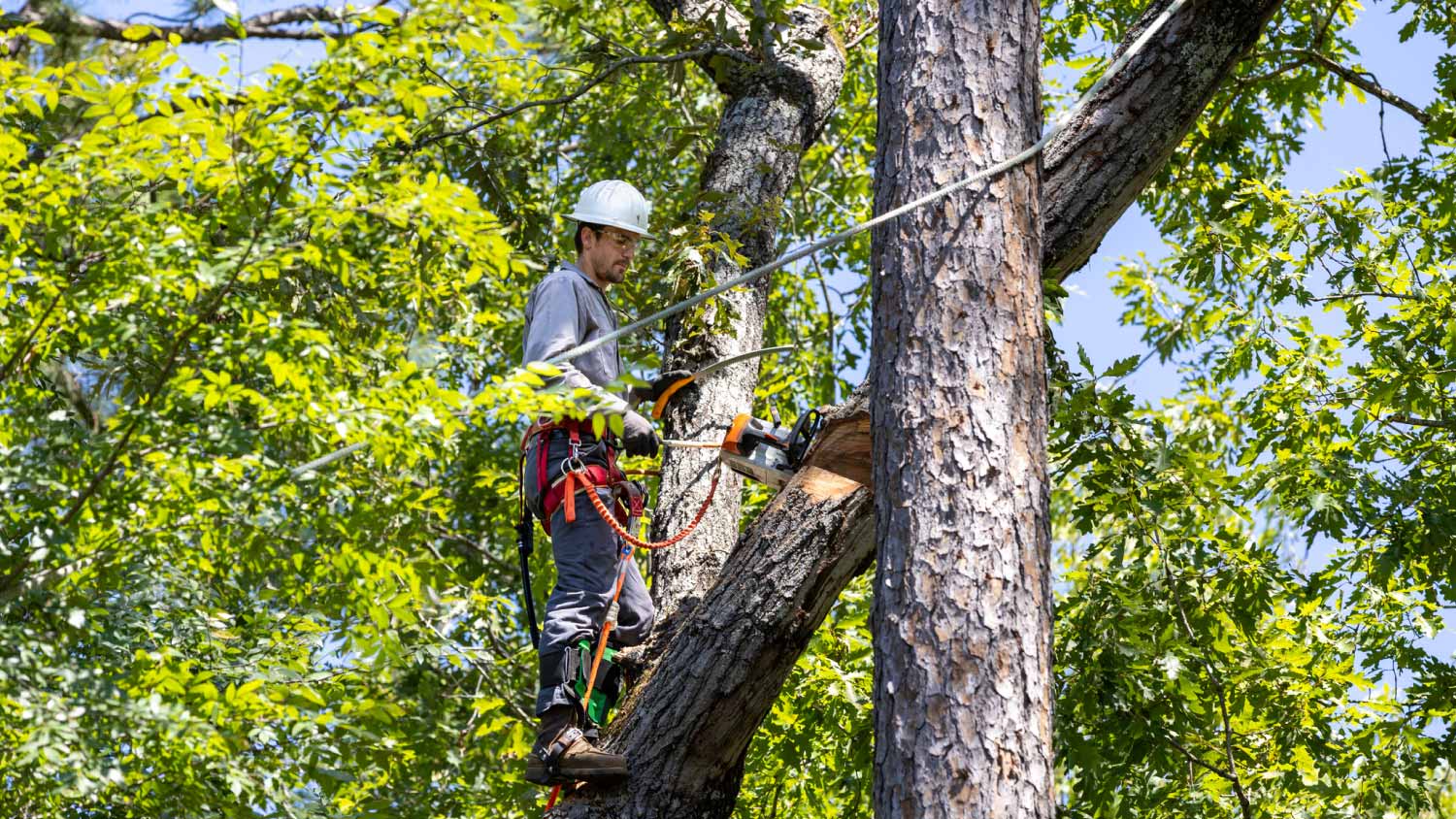The Complete Guide to Getting Rid of Cankerworms (and Which Trees Are Most Susceptible)
Don’t let these little nuisances worm their way into your trees


Cankerworms feed on foliage, causing long-term tree damage.
Tree banding is a safe way to get rid of cankerworms.
Insecticide treatments prevent cankerworm damage the best.
You probably don’t often hear about cankerworms, but it’s likely you’ve seen them more than once during your outdoor adventures. Often referred to as inchworms, cankerworms appear during the springtime and are light green to brown in color.
Cankerworms may seem harmless (if not a bit annoying), but they can damage trees and become a headache for homeowners. This comprehensive guide will provide you with everything you need to know about getting rid of cankerworms and the dangers these menaces create.
What Are Cankerworms?
Cankerworms are referred to in a number of ways, including inchworms, loopers, and spanworms. These pests move in a distinctive looping pattern and appear in the spring and fall seasons.
During the fall season, male and female cankerworms mate. The female cankerworms lay their eggs on small tree branches. The eggs hatch the following spring and, once hatched, the cankerworms begin feeding on fresh foliage. While cankerworms in the spring are the primary menaces that cause damage to trees, you’ll want to take action in the fall.
Why Are Cankerworms Dangerous?

The cankerworm’s springtime appearance usually lasts a few weeks or so, but they can often be a nuisance, as there is an abundance of them. You’re likely to find them dropping from your doors and windows and finding their way onto your beautiful lawn and patio furniture.
While annoying, cankerworms are fairly harmless except when it comes to one thing in your yard: trees. After leaves fully develop in early spring, cankerworms hatch to feed on the fresh foliage. This causes defoliation that can result in branch dieback, root decline, and borer damage, which destroys water-conducting and sap-conducting tissues that leads to structural weakness.
In most cases, one year of defoliation won’t completely damage your trees, but after two to three years, your trees can completely defoliate, and you may need to remove them.
Tree removal costs anywhere from $200 to $2,000. If you can’t bear the thought of saying goodbye to the gorgeous oak trees in your yard, you’ll want to get rid of and prevent cankerworms sooner rather than later.
Trees Susceptible to Cankerworm Damage
Cankerworms feed on a large range of deciduous trees and small woody plants. Most commonly, cankerworms will host on the following trees:
Oak
Maple
Cherry
Ash
Apple
Birch
Get Rid of Cankerworms With Tree Banding
Tree banding is a natural approach to getting rid of cankerworms. The process involves wrapping tree trunks with sticky bands, which can be found at home improvement stores.
Why does this work? Female cankerworms are wingless, so in the fall, when they lay their eggs, they crawl up the trees. Tree banding traps the female cankerworms by preventing them from crawling further up the tree to the branches where they lay their eggs.
While this all-natural approach is ideal for many homeowners, there are some limitations and drawbacks to using this method to prevent cankerworm damage. Due to the sticky substance, leaves and debris can attach to the trunk. This creates a bridge over the sticky band that allows the cankerworms a path to lay their eggs.
Sticky bands also require maintenance. You can remove any leaves and debris that stick to the trunk of the tree to maintain its effectiveness. The bands will also need replacing due to deterioration, so check in on them periodically.
It should also be noted that tree banding is expensive, messy, and can leave a permanent mark on the trees. However, if you’re committed to practicing an all-natural approach to getting rid of cankerworms, this method is highly effective.
The Best Pesticides for Getting Rid of Cankerworms
Insecticide treatments are the most effective way to get rid of cankerworms. The process is also much easier, especially if you’re dealing with larger trees, like maple or birch. While you could hire a local lawn pest control specialist to take care of the job, you can also resolve the infestation yourself.
Timing is everything when you’re preparing to use pesticides. You want to apply the treatments while the cankerworms are fairly small and haven’t caused too much damage yet. When your trees are just beginning to bud, that’s the best time to get started. You won’t want to wait too long because by the third or fourth week of the eggs hatching, they’re large enough in size to cause major damage to your favorite shady spots.
There are lots of pesticide options to choose from but the best option is the bacterial insecticide Bacillus thuringiensis. This particular insecticide is completely safe for the environment, so no need to worry about the safety of your family, pets, wildlife, or other plants.
While Bacillus thuringiensis is considered safe, you do want to err on the side of caution while applying. Wear gloves, long-sleeves, and pants during application and wash thoroughly upon completion.
If you have any questions or concerns about using pesticides or the health of your trees, contact a local arborist. You can even choose to hire an arborist for regular inspections to monitor and control cankerworm outbreaks.





- How to Protect Trees From Frost and Prevent Damage
- Here’s Where To Plant Trees In Your Backyard
- When To Cut Down A Tree: 13 Ways To Tell
- Who Removes Fallen Trees From Roads?
- Never Do This When Cutting Down a Tree
- The Power of Trees: Learn Which Ones Can Make Your Property Value Flourish
- 9 Ways to Protect Your Trees From Winter Storms
- Can You Cut Down a Tree on Your Property?
- How to Choose Between a Real or an Artificial Christmas Tree
- How to Tell What Type of Tree You Have in Your Yard










